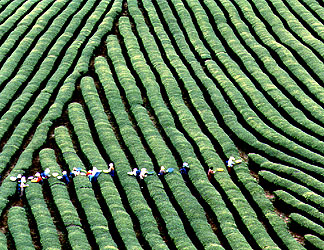p.jpg)

|
The
history of tea in Korea goes back to 828 A.D. when tea
was first brought from China. The King gave an order to plant tea
on Mt. Chiri and this made Cholla and Kyongsang
province the home of tea.
During the Koryo Dynasty, tea was drunk in
everyday lives by the royal family and nobility. During
this period, tea was popular among the Buddhist priests
and Dado, the manner
of drinking tea was developed
by the priests. The tea culture also had an influence
on the development of Koryo
Blue Celadon. Dado dwindled
in the Chosun Dynasty due to the restrictions on Buddhism
and the emphasis on living a modest life style. But
in the latter Chosun Dynasty, Dado regained its popularity
thanks to priest Choeui(1786-1866) of Ilji-am. Also it is said
that a great scholar and politician Jung, Yak-Yong was
fasci-
nated by the when he was exiled to Kangjin
during the prosecution of Catholics and had a friendship
with the priest Choeui.
|